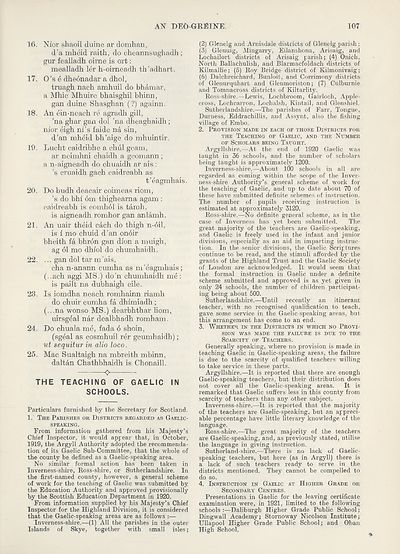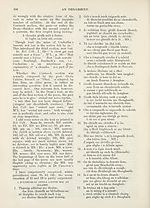An Comunn Gàidhealach Publications > Deo-gréine > Volume 17, October 1921 to September 1922
(115) Page 107
Download files
Complete book:
Individual page:
Thumbnail gallery: Grid view | List view

AN DEO-GREINE.
107
16. Nior shaoil duine ar domhan,
d’a mheid raith, do cheannsughadh;
gur fealladh oirne is ort:
mealladh ler h-oirneadh th’adhart.
17. O’s e dheonadar a dhol,
truagh nach amhuil do bMmar,
a Mhic Mhuire bhaisghil bhinn,
gan duine Shasghan (?) againn.
18. An ein-neach re agradh gill,
’na ghar gan dol ’na dheaghaidh ;
nior eigh ni’s faide na sin,
d’an mh&d bh’aige do mhuintir.
19. Lucht caidribhe a chul gcam,
ar neimhni chaidh a gcomann;
a n-aigneadh do chuaidh ar ais :
’s cruaidh gach caidreabh as
t’eagmhais.
20. Do budh deacair coimeas riom,
’s do bhi 6m thigheama agam:
caidreabh is comhbl is tamh,
is aigneadh romhor gan anlamh.
21. An uair theid each do thigh n-6il,
is i mo chuid d’an on6ir
bheith fa bhr6n gan dion a muigh,
ag 61 mo dhiol do chumhaidh.
22. ... gan dol tar m’ais,
cha n-anann cumha as m ’eagmhais;
(..ach aggi MS.) do’n chumhaidh me :
is pailt na dubhaigh eile.
23. Is iomdha neach romhainn riamh
do chuir cumha fa dhimiadh;
(...na wonso MS.) dearbhthar Horn,
uirsg6al nar dealbhadh romham.
24. Do chuala m6, fada 6 shoin,
(sg6al as cosmhuil rer gcumhaidh);
ut sequitur in alio loco.
25. Mac Sualtaigh na mbreith mbinn,
daltan Chathbhaidh is Chonaill.
0
THE TEACHING OF GAELIC IN
SCHOOLS.
Particulars furnished by the Secretary for Scotland.
1. The Parishes or Districts regarded as Gaelic¬
speaking.
From information gathered from his Majesty’s
Chief Inspector, it would appear that, in October,
1919, the Argyll Authority adopted the recommenda¬
tion of its Gaelic Sub-Committee, that the whole of
the county be defined as a Gaelic-speaking area.
No similar formal action has been taken in
Inverness-shire, Ross-shire, or Sutherlandshire. In
the first-named county, however, a general scheme
of work for the teaching of Gaelic was submitted by
the Education Authority and approved provisionally
by the Scottish Education Department in 1920.
From information supplied by his Majesty’s Chief
Inspector for the Highland Division, it is considered
that the Gaelic-speaking areas are as follows :—
Inverness-shire.—(1) All the parishes in the outer
Islands of Skye, together with small isles;
(2) Glenelg and Arnisdale districts of Glenelg parish;
(3) Glenuig, Mingarry, Eilanshona, Arisaig, and
Lochailort districts of Arisaig parish; (4) Onich,
North Ballachulish, and Blarmacfoldach districts of
Kilmallie; (5) Roy Bridge district of Kilmonivaig;
(6) Dalchreichard, Bunloit, and Corrimony districts
of Glenurquhart and Glenmoriston; (7) Culburnie
and Tomnacross districts of Kiltarlity.
Ross-shire.—Lewis, Lochbroom, Gairloch, Apple-
cross, Lochcarron, Lochalsh, Kintail, and Glenshiel.
Sutherlandshire.—The parishes of Farr, Tongue,
Durness, Eddrachillis, and Assynt, also the fishing
village of Embo.
2. Provision made in each of those Districts for
the Teaching of Gaelic, and the Number
of Scholars being Taught.
Argyllshire.—At the end of 1920 Gaelic was
taught in 36 schools, and the number of scholars
being taught is approximately 1200.
Inverness-shire.—About 100 schools in all are
regarded as coming within the scope of the Inver¬
ness-shire Authority’s general scheme of work for
the teaching of Gaelic, and up to date about 70 of
these have submitted definite schemes of instruction.
The number of pupils receiving instruction is
estimated at approximately 3120.
Ross-shire.—No definite general scheme, as in the
case of Inverness has yet been submitted. The
great majority of the teachers are Gaelic-speaking,
and Gaelic is freely used in the infant and junior
divisions, especially as an aid in imparting instruc¬
tion. In the senior divisions, the Gaelic Scriptures
continue to be read, and the stimuli afforded by the
grants of the Highland Trust and the Gaelic Society
of London are acknowledged. It would seem that
the formal instruction in Gaelic under a definite
scheme submitted and approved is as yet given in
only 24 schools, the number of children participat¬
ing being about 500.
Sutherlandshire.—Until recently an itinerant
teacher, with no recognised qualification to teach,
gave some service in the Gaelic-speaking areas, but
this arrangement has come to an end.
3. Whether in the Districts in which no Provi¬
sion WAS MADE THE FAILURE IS DUE TO THE
Scarcity of Teachers.
Generally speaking, where no provision is made in
teaching Gaelic in Gaelic-speaking areas, the failure
is due to the scarcity of qualified teachers willing
to take service in these parts.
Argyllshire.—It is reported that there are enough
Gaelic-speaking teachers, but their distribution does
not cover all the Gaelic-speaking areas. It is
remarked that Gaelic suffers less in this county from
scarcity of teachers than any other subject.
Inverness-shire.—It is reported that the majority
of the teachers are Gaelic-speaking, but an appreci¬
able percentage have little literary knowledge of the
language.
Ross-shire.—The great majority of the teachers
are Gaelic-speaking, and, as previously stated, utilise
the language in giving instruction.
Sutherland-shire.—There is no lack of Gaelic¬
speaking teachers, but here (as in Argyll) there is
a lack of such teachers ready to serve in the
districts mentioned. They cannot be compelled to
do so.
4. Instruction in Gaelic at Higher Grade or
Secondary Centres.
Presentations in Gaelic for the leaving certificate
examination were, in 1921, limited to the following
schools :—Daliburgh Higher Grade Public School;
Dingwall Academy; Stornoway Nicolson Institute;
Ullapool Higher Grade Public School; and Oban
High School,
107
16. Nior shaoil duine ar domhan,
d’a mheid raith, do cheannsughadh;
gur fealladh oirne is ort:
mealladh ler h-oirneadh th’adhart.
17. O’s e dheonadar a dhol,
truagh nach amhuil do bMmar,
a Mhic Mhuire bhaisghil bhinn,
gan duine Shasghan (?) againn.
18. An ein-neach re agradh gill,
’na ghar gan dol ’na dheaghaidh ;
nior eigh ni’s faide na sin,
d’an mh&d bh’aige do mhuintir.
19. Lucht caidribhe a chul gcam,
ar neimhni chaidh a gcomann;
a n-aigneadh do chuaidh ar ais :
’s cruaidh gach caidreabh as
t’eagmhais.
20. Do budh deacair coimeas riom,
’s do bhi 6m thigheama agam:
caidreabh is comhbl is tamh,
is aigneadh romhor gan anlamh.
21. An uair theid each do thigh n-6il,
is i mo chuid d’an on6ir
bheith fa bhr6n gan dion a muigh,
ag 61 mo dhiol do chumhaidh.
22. ... gan dol tar m’ais,
cha n-anann cumha as m ’eagmhais;
(..ach aggi MS.) do’n chumhaidh me :
is pailt na dubhaigh eile.
23. Is iomdha neach romhainn riamh
do chuir cumha fa dhimiadh;
(...na wonso MS.) dearbhthar Horn,
uirsg6al nar dealbhadh romham.
24. Do chuala m6, fada 6 shoin,
(sg6al as cosmhuil rer gcumhaidh);
ut sequitur in alio loco.
25. Mac Sualtaigh na mbreith mbinn,
daltan Chathbhaidh is Chonaill.
0
THE TEACHING OF GAELIC IN
SCHOOLS.
Particulars furnished by the Secretary for Scotland.
1. The Parishes or Districts regarded as Gaelic¬
speaking.
From information gathered from his Majesty’s
Chief Inspector, it would appear that, in October,
1919, the Argyll Authority adopted the recommenda¬
tion of its Gaelic Sub-Committee, that the whole of
the county be defined as a Gaelic-speaking area.
No similar formal action has been taken in
Inverness-shire, Ross-shire, or Sutherlandshire. In
the first-named county, however, a general scheme
of work for the teaching of Gaelic was submitted by
the Education Authority and approved provisionally
by the Scottish Education Department in 1920.
From information supplied by his Majesty’s Chief
Inspector for the Highland Division, it is considered
that the Gaelic-speaking areas are as follows :—
Inverness-shire.—(1) All the parishes in the outer
Islands of Skye, together with small isles;
(2) Glenelg and Arnisdale districts of Glenelg parish;
(3) Glenuig, Mingarry, Eilanshona, Arisaig, and
Lochailort districts of Arisaig parish; (4) Onich,
North Ballachulish, and Blarmacfoldach districts of
Kilmallie; (5) Roy Bridge district of Kilmonivaig;
(6) Dalchreichard, Bunloit, and Corrimony districts
of Glenurquhart and Glenmoriston; (7) Culburnie
and Tomnacross districts of Kiltarlity.
Ross-shire.—Lewis, Lochbroom, Gairloch, Apple-
cross, Lochcarron, Lochalsh, Kintail, and Glenshiel.
Sutherlandshire.—The parishes of Farr, Tongue,
Durness, Eddrachillis, and Assynt, also the fishing
village of Embo.
2. Provision made in each of those Districts for
the Teaching of Gaelic, and the Number
of Scholars being Taught.
Argyllshire.—At the end of 1920 Gaelic was
taught in 36 schools, and the number of scholars
being taught is approximately 1200.
Inverness-shire.—About 100 schools in all are
regarded as coming within the scope of the Inver¬
ness-shire Authority’s general scheme of work for
the teaching of Gaelic, and up to date about 70 of
these have submitted definite schemes of instruction.
The number of pupils receiving instruction is
estimated at approximately 3120.
Ross-shire.—No definite general scheme, as in the
case of Inverness has yet been submitted. The
great majority of the teachers are Gaelic-speaking,
and Gaelic is freely used in the infant and junior
divisions, especially as an aid in imparting instruc¬
tion. In the senior divisions, the Gaelic Scriptures
continue to be read, and the stimuli afforded by the
grants of the Highland Trust and the Gaelic Society
of London are acknowledged. It would seem that
the formal instruction in Gaelic under a definite
scheme submitted and approved is as yet given in
only 24 schools, the number of children participat¬
ing being about 500.
Sutherlandshire.—Until recently an itinerant
teacher, with no recognised qualification to teach,
gave some service in the Gaelic-speaking areas, but
this arrangement has come to an end.
3. Whether in the Districts in which no Provi¬
sion WAS MADE THE FAILURE IS DUE TO THE
Scarcity of Teachers.
Generally speaking, where no provision is made in
teaching Gaelic in Gaelic-speaking areas, the failure
is due to the scarcity of qualified teachers willing
to take service in these parts.
Argyllshire.—It is reported that there are enough
Gaelic-speaking teachers, but their distribution does
not cover all the Gaelic-speaking areas. It is
remarked that Gaelic suffers less in this county from
scarcity of teachers than any other subject.
Inverness-shire.—It is reported that the majority
of the teachers are Gaelic-speaking, but an appreci¬
able percentage have little literary knowledge of the
language.
Ross-shire.—The great majority of the teachers
are Gaelic-speaking, and, as previously stated, utilise
the language in giving instruction.
Sutherland-shire.—There is no lack of Gaelic¬
speaking teachers, but here (as in Argyll) there is
a lack of such teachers ready to serve in the
districts mentioned. They cannot be compelled to
do so.
4. Instruction in Gaelic at Higher Grade or
Secondary Centres.
Presentations in Gaelic for the leaving certificate
examination were, in 1921, limited to the following
schools :—Daliburgh Higher Grade Public School;
Dingwall Academy; Stornoway Nicolson Institute;
Ullapool Higher Grade Public School; and Oban
High School,
Set display mode to:
![]() Universal Viewer |
Universal Viewer | ![]() Mirador |
Large image | Transcription
Mirador |
Large image | Transcription
| An Comunn Gàidhealach > An Comunn Gàidhealach Publications > Deo-gréine > Volume 17, October 1921 to September 1922 > (115) Page 107 |
|---|
| Permanent URL | https://digital.nls.uk/127171353 |
|---|
| Description | Leabhar 17, Treasamh Mios an Fhoghair 1921 gu Dara Mìos an Fhoghair 1922 |
|---|---|
| Attribution and copyright: |
|
| Description | This contains items published by An Comunn, which are not specifically Mòd-related. It includes journals, annual reports and corporate documents, policy statements, educational resources and published plays and literature. It is arranged alphabetically by title. |
|---|
| Description | A collection of over 400 items published by An Comunn Gàidhealach, the organisation which promotes Gaelic language and culture and organises the Royal National Mòd. Dating from 1891 up to the present day, the collection includes journals and newspapers, annual reports, educational materials, national Mòd programmes, published Mòd literature and music. |
|---|---|
| Additional NLS resources: |
|

